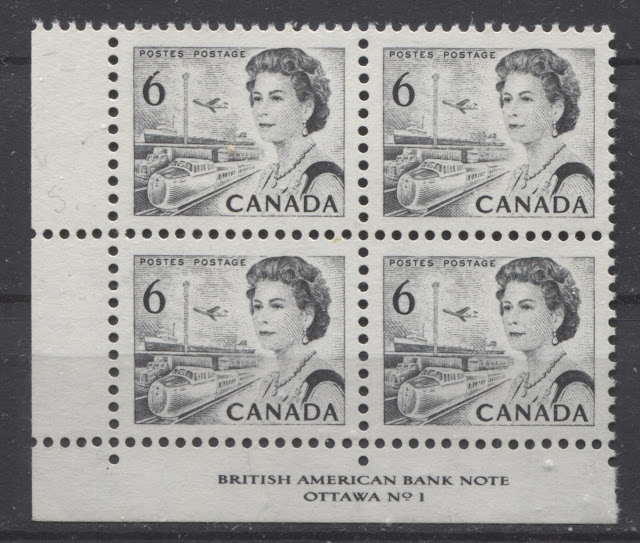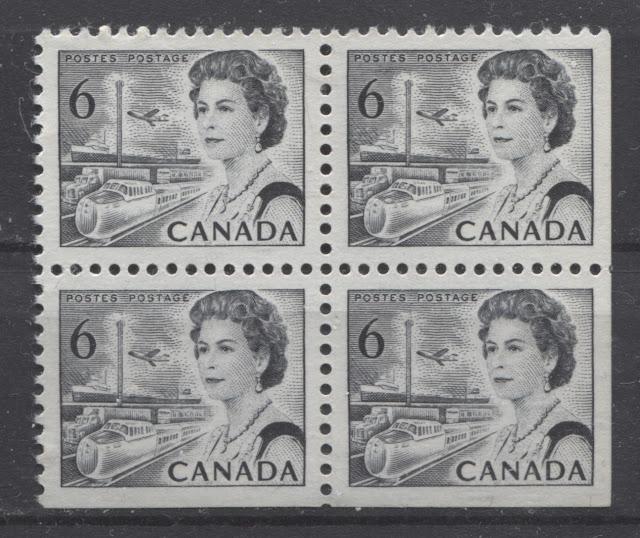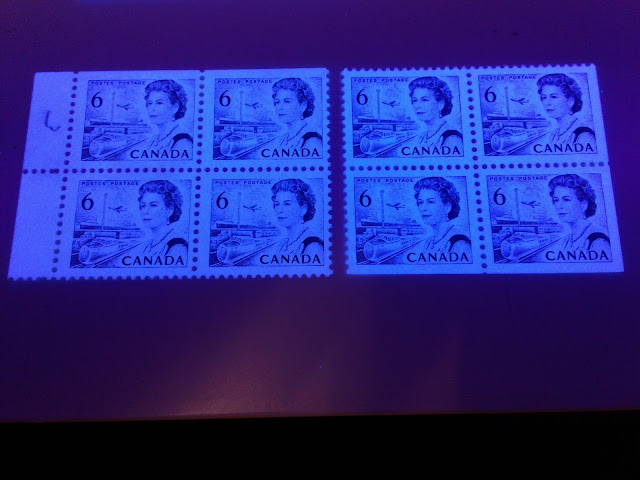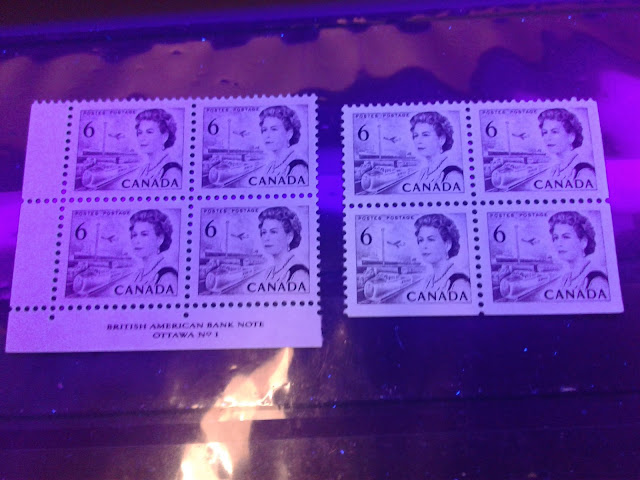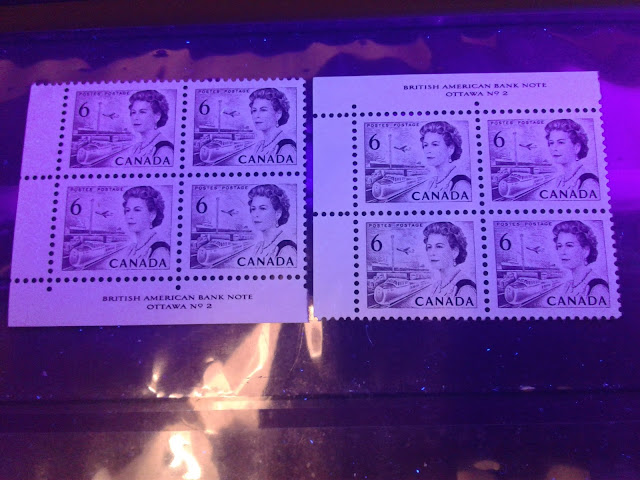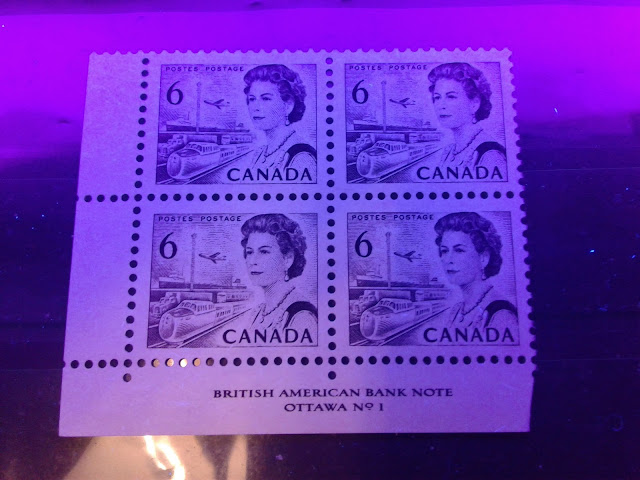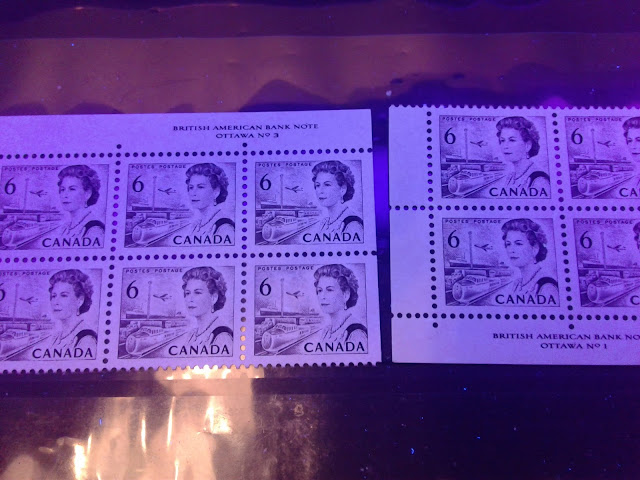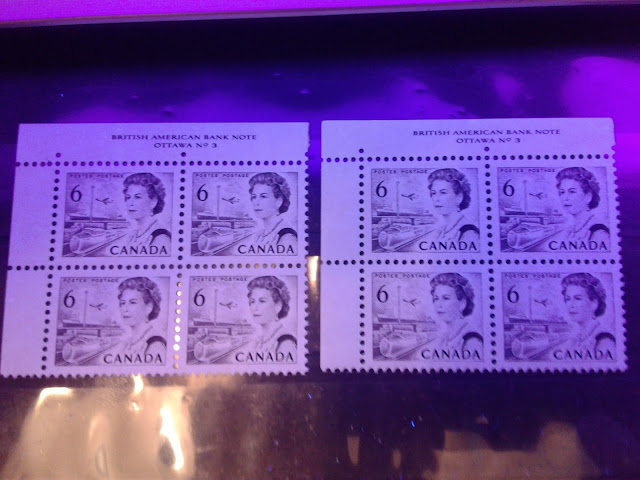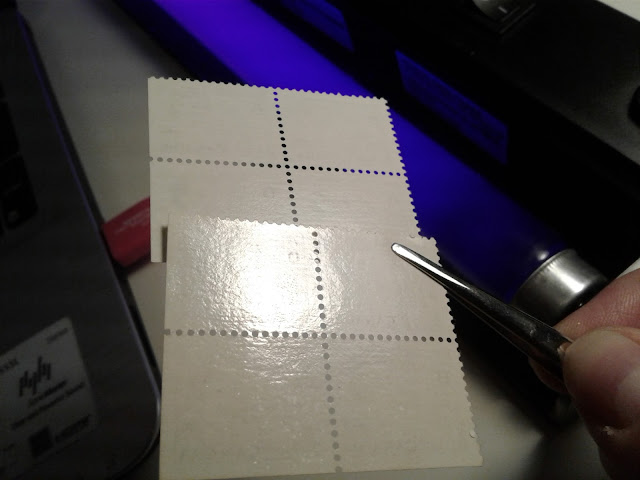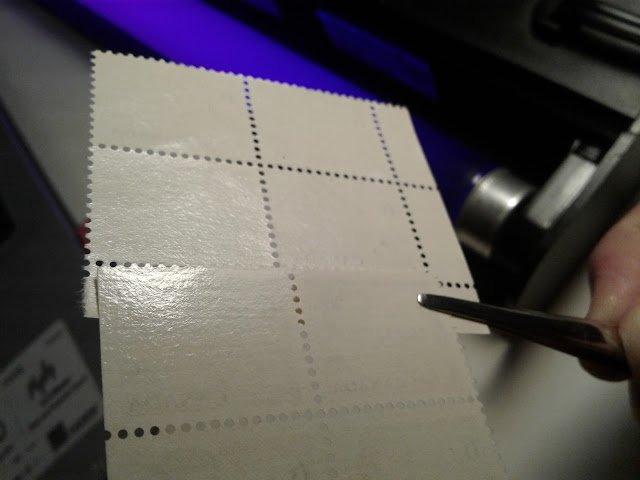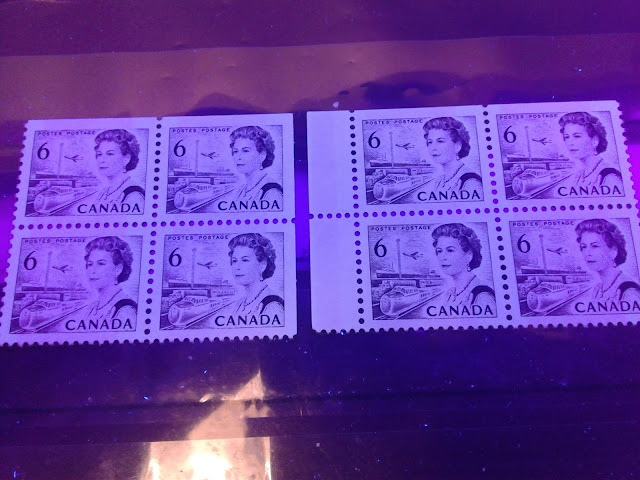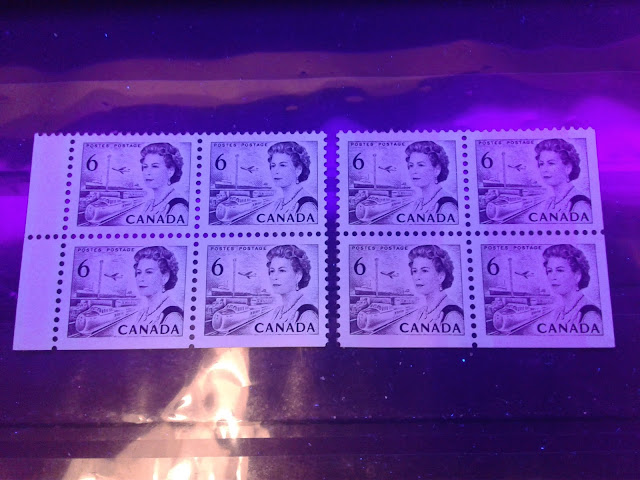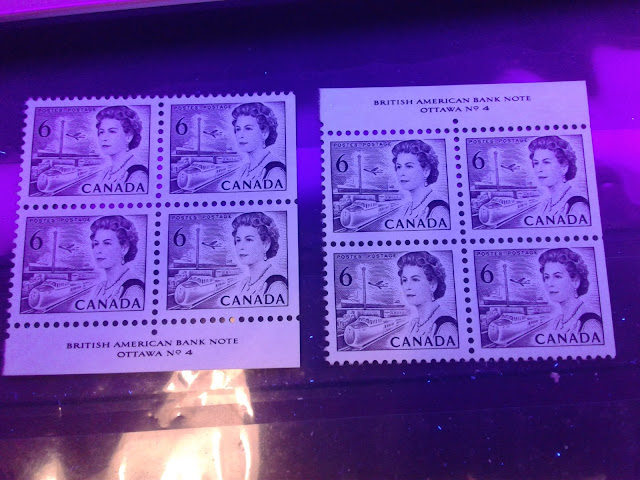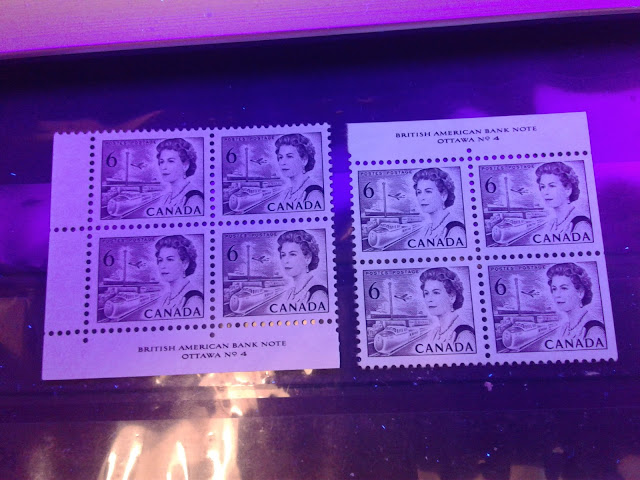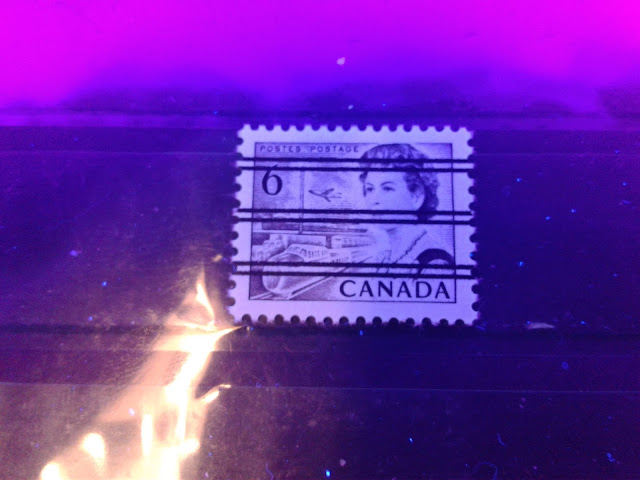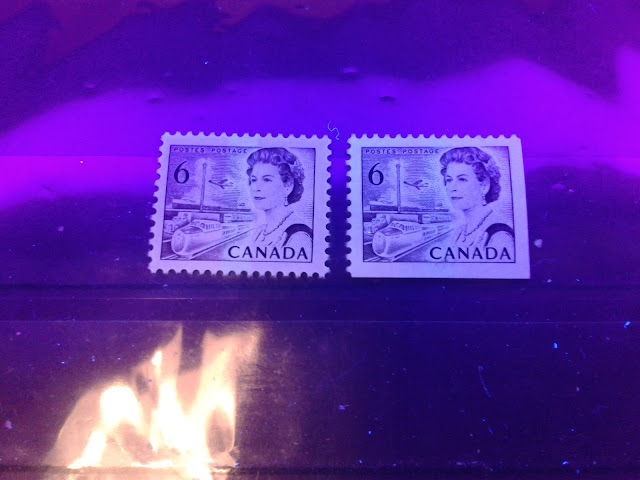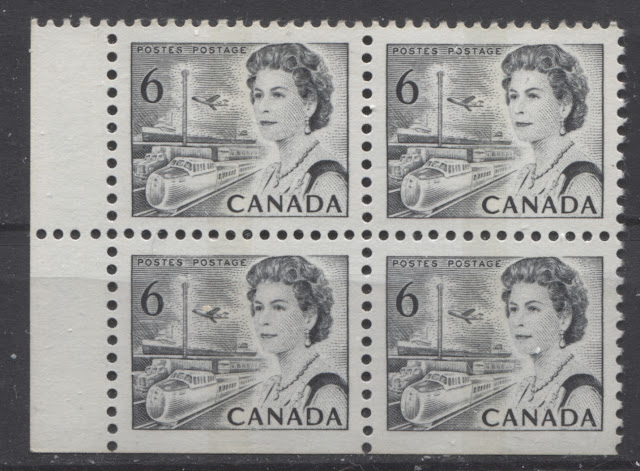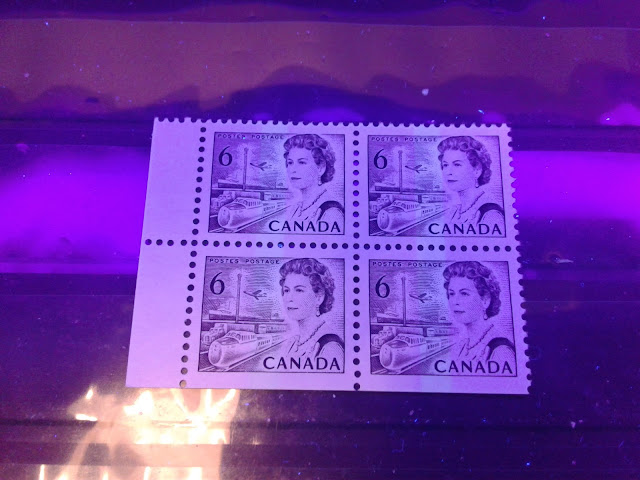Of all the low values in the series, this is one of the most complex, along with the 8c slate Parliamentary library design. One of the reasons is that the sheet stamps were printed by both the BABN and the CBN, while there were several different printings of three basic stamp booklets, all printed by the BABN. This value includes one of the rarest Centennial issue items: the booklet of 25 on hibrite paper, which Unitrade values at $4,500, and which trades very infrequently. Because of this complexity, I will cover this value in 4 posts:
1. The sheet stamps printed by BABN will be covered this week.
2. The sheet stamps printed by CBN and the coil stamps will be covered next week.
3. The perf. 10 booklet stamps and the perf. 12.5 x 12 booklet stamps from the $1.50 booklets and 25c booklets containing 4 stamps will be covered the following week.
4. The perf. 12.5 x 12 booklet stamps from the 25c booklets containing the 1c, 6c and 8c stamps (BK69 and BK71) will be covered the week after.
This is the first and only stamp in the series to have been printed from three dies, two of which are attributed to the BABN printings: die 1 and die 2. Both dies exist with different configurations of Winnipeg tagging, and the die 2 stamps only exist precancelled. Unitrade lists a slight doubling of the "6" on the die 2 sheet stamps, and no paper varieties at all, while on the die 1's they list dull fluorescent, low fluorescent flecked and hibrite papers.
The Die Type Differences
- The background shading is weak and uneven, with the strongest lines being at the edges of the design.
- The right frameline is thin and weak.
- The background shading is of completely even strength, regardless of where in the design, the lines fall. This gives the design a very flat appearance.
- The right frameline is thick and solid.
The Untagged Die 1 Sheet Stamps - Unitrade #460, 460i and 460ii
Paper Characteristics Other Than Fluorescence
The paper used to print these stamps is generally a horizontal wove, but shows some variation in the physical characteristics other than fluorescence as follows:
- One paper type is a bright white, that appears only very slightly off-white when viewed against a stark white background. This paper is hibrite under UV. The printing surface is smooth under magnification, but clearly uncoated. The paper shows no clear mesh pattern when viewed against a strong back light.
- Another paper is light cream colour when viewed against a stark white background, and shows very light vertical ribbing on the surface, when viewed at an angle to the light. Again, the printing surface is smooth under magnification, but clearly uncoated. The vertical mesh pattern shows up clearly when the paper is viewed against a strong back-light.
- A third paper is light cream in colour when viewed against a stark white background, and shows no ribbing on the surface. The printing surface is smooth and uncoated when viewed under magnification. No clear mesh pattern is visible when the paper is viewed against strong back-lighting.
Paper Fluorescence
Unitrade lists three basic levels of fluorescence on this stamp, all of which exhibit some variations, both in terms of colour under UV light, and the brightness and concentration of fluorescent fibres embedded in the paper: dull fluorescent, low fluorescent and hibrite.
Hibrite Papers
I have found two varieties of the hibrite paper, as shown below:
Both varieties are still sufficiently bright that I would call them true hibrites, but the paper of the block on the left is not quite as bright as the block on the right. The block on the left has a less bluish white appearance, and the fluorescence has a somewhat mottled appearance, whereas the block on the right has a solid, bluish white look to it.
Dull Fluorescent Papers
I have found five varieties of the dull fluorescent paper as shown in the pictures below. Three of these are variations of a dull fluorescent greyish paper, while one is a dull fluorescent greyish white, while the other is dull fluorescent ivory.
Here, we have the dull fluorescent greyish paper on the left, and the greyish white paper on the right. In neither case are there any obvious fluorescent fibres present. However, if you look very closely at both blocks with a 10x loupe, you can see fluorescent fibres in both papers. The grey paper on the left has very few low fluorescent fibres - maybe 10 in the whole block. The greyish white block contains a very sparse concentration of low fluorescent fibres, very few medium fluorescent fibres and 1-2 high fluorescent fibres. Again, though, there are not enough of these fibres present in either case to make the paper appear brighter than dull fluorescent overall.
Here we have another version of the dull fluorescent greyish paper on the left and a dull fluorescent ivory paper on the right. In both cases, without the aid of a loupe, you can make out a few fluorescent fibres in each block. Looking at them more closely, the block on the left contains a very sparse concentration of low fluorescent fibres, very few high fluorescent fibres and very few hibrite fibres. The block on the right, on the other hand has a very sparse concetration of low fluorescent fibres, very few medium fluorescent and very few high fluorescent fibres. Again, there are not enough of these fibres to significantly alter the overall perceived fluorescence level of the paper.
Finally, here we have a third version of the greyish paper, this time with many more fluorescent fibres than the other two. You can see these easily in the selvage at the upper right of the bottom selvage tab, and to the lower left of "British". On this paper there are very sparse concentrations of low and medium fluorescent fibres and very few high fluorescent fibres. Again, though, there are still not enough fibres of sufficient brightness to make this paper appear brighter than dull fluorescent.
Low Fluorescent Papers
I studying this stamp, I have found four types of the low fluorescent paper. All of them contain obvious concentrations of fluorescent fibres that can be seen without a loupe. In all cases, the ambient fluorescence of the paper is either dull fluorescent greyish, or dull fluorescent ivory, but there is a sufficient number of fluorescent fibres, of sufficient brightness to make the paper appear low fluorescent overall. The pictures below show all four types:
Here we have the low fluorescent bluish white and low fluorescent ivory papers. The bluish white paper contains a low density concentration of low fluorescent fibres, a sparse concentration of medium fluorescent fibres and then very few high fluorescent ones. The ivory paper on the other hand contains a sparse concentration of low fluorescent fibres, very few high fluorescent fibres and very few hibrite fibres.
Here we have a low fluorescent greyish paper on the left, and another version of the ivory paper on the right, this one containing more fluorescent fibres than the paper above. The greyish paper contains a low density concentration of low fluorescent fibres and very few medium fluorescent ones. The ivory paper shown here contains sparse concentrations of low and medium fluorescent fibres, and very few high fluorescent fibres.
It would appear that the fluorescence levels are not specific to any particular plate. I would assume therefore that plates 1, 2 and three can be found with any of the dull and low fluorescent papers. The hibrite paper is only found in field stock, so it is not possible to pinpoint which of the three plates the hibrite paper stamps were printed from, or if they came from all three plates.
Shades
The black ink used to print these stamps seems to be highly uniform. There is a hint of silver-grey to the black ink.
Gum
I have found three different types of dextrose gum on these stamps, each of which I will illustrate here:
- A smooth, cream coloured gum that shows a very fine diagonal crack pattern on the surface and has a satin sheen.
- A smooth, cream coloured gum that has a semi-gloss sheen and often gives the appearance of having very fine horizontal brushstrokes running through it.
- A smooth, cream coloured gum that has a glossy sheen and has the appearance of having very fine horizontal brushstrokes running through it.
In this picture, we have the crackly gum on the top block, and the semi-gloss gum on the bottom block.
Perforation
These stamps are comb perforated 12.5 x 12. I have not seen, or heard of any variations in the perforation.
Bringing it All Together
Three plates were used to print these stamps. I have no reason to believe that all three plates cannot be found with all combinations of the paper types and fluorescence levels. I have found three paper types, two types of hibrite paper, five types of dull fluorescent paper and four types of low fluorescent paper. I have also found three types of gum. Based on these observations the number of collectible paper and gum varieties for each paper type should be:
- Type 1: 2 x 3 = 6 stamps
- Type 2: (2 x 3) + (5 x 3) + (4 x 3) = 33 stamps
- Type 3: (5 x 3) + (4 x 3) = 27 stamps
- Type 1: 6 x 20 = 120 blank blocks.
- Type 2: (6 x 20) + (15 x 32) + (12 x 32) = 324 plate blocks and 660 blank blocks.
- Type 3: (15 x 32) + (12 x 32) = 324 plate blocks and 540 blank blocks.
The Winnipeg Tagged Die 1 Sheet Stamps - Unitrade #460p and #460pi
Paper Characteristics Other Than Fluorescence
The paper used to print these stamps shows similar variation to the untagged stamps, except that no hibrite paper has as yet been seen. So there is no type 1 paper. However, types 2 and 3, as noted on the untagged stamps has been found to exist.
Paper Fluorescence
Unitrade lists the tagged stamps as existing on both the dull fluorescent and low fluorescent papers. There has not, as yet been any discovery of a hibrite version. I have found three varieties of the dull fluorescent paper and would note that only one of them appears to contain the fluorescent fibres that the other dull fluorescent papers of the untagged stamps contained.
Shades
The shades found on the tagged stamps are identical to those found on the untagged stamps, which is to say an intense black that contains a silver-grey tone.
Gum
I have only found one type of dextrose gum on all the tagged blocks that I have examined, being the semi-gloss smooth gum, showing the appearance of horizontal brushstrokes.
Perforation
Like the untagged stamps, the tagged stamps are comb perforated 12.5 x 12. I have not found any variations in the perforation for these stamps either.
Winnipeg Tagging
The Winnipeg tagging is extremely difficult to see on these stamps and is often overlooked by collectors. One has to look for a line of very slight discoloration at the sides of the stamps. The tagging bars were normally 8 mm wide, and were applied down the vertical perforations between the stamps. However, the outer bands applied down the outer perforations of the outside panes in the sheet layout were only 5 mm wide.
The picture below shows a blank block from one of the centre panes, that has the normal 8 mm tagging, as well as an upper left block from an outer pane that has the narrower tagging bar at the left:
Can you see the tagging bars on these two blocks? It is very difficult isn't it? If you look in the left selvage tab of the right block, you should be able to make out a light vertical line where the paper appears slightly lighter under UV. This is the tagging bar. Then if you relax your gaze and look at the right side of the block, you should be able to just see the right tagging bar, and finally the middle bar.
The bars should be easier to see in the next picture, which shows the dull fluorescent greyish paper and dull fluorescent greyish white paper:

- It could be a regular Winnipeg 2-Bar tagged sheet in which one of the 8 mm tagging bars has been omitted.
- It could be a true 1-bar tagging error from a leftward shift, where the bar on the right is a bar that should have been on another pane of stamps and the left bar should have been the right bar.
According to Mr. Hecht, the spacing between the two tag bars is 33 mm. Usually, the spacing between bars on properly tagged W2B stamps is between 14 mm and 17 mm. So, it seems unlikely that this spacing is merely consistent with an omitted tagging bar, as the spacing between bars if that omitted bar were there would be 33 mm - 8 mm = 25 mm, which is too small. Thus it does seem as though this may be an error resulting from a severe leftward shift of at least 33 mm, of the tagging bars. I'd be interested to know what anyone else thinks of this.
Bringing it All Together
This stamp is much simpler to collect than the untagged stamp, as there does not appear to be any significant variation in either the tagging, nor the gum. There are two different types of paper, which could exist with at least four different levels of fluorescence. So, there may be as many as eight different collectible stamps, and up to 160 different blank corner blocks that may be collected.
The Untagged Die 2 Sheet Stamps - Unitrade #460c, 460civ and 460xx
Paper Characteristics Other Than Fluorescence
Like the die 1 stamps, the paper used to print the die 2 stamps is a horizontal wove paper. I found two different types of paper:
- A cream coloured wove, showing very light vertical ribbing on the surface, but only when the paper is held at an angle to the light, otherwise it appears perfectly smooth. Under magnification, the printing surface appears smooth, with a very light surface coating being visible on the paper. When held up to a strong back light and viewed, the vertical mesh pattern in the paper is very clearly visible.
- As above, except that there is no ribbing, and no clear mesh pattern visible when the paper is held up to a strong back-light.
Paper Fluorescence
Unitrade only lists this stamp as existing on dull fluorescent paper, and I believe that Unitrade is correct. However, within the classification of dull fluorescent, I have found three sub-varieties: dull fluorescent greyish, dull fluorescent greyish white and dull fluorescent ivory. None of these papers contain any fluorescent fibres either. The pictures below show each of the three types:
This picture shows the dull fluorescent greyish white on the left and the ivory on the right. Although they do appear very similar, the colour of the ivory paper is less greyish and more cream under UV, than the greyish white.
This picture shows the clear difference between the greyish paper, which is shown on the left, and the ivory paper shown on the right.
Shades
The shade of the die 2 stamps is a more pure, intense black that does not have the silver-grey tone that one sees on the die 1 stamps.
Gum
This stamp exists with all three types of dextrose gum previously discussed.
Perforation
The perforation remains unchanged at 12.5 x 12 comb, consistent with the die 1 stamps.
Plate Flaws
Unitrade lists a plastic flow variety on this value in which the "6" is partially doubled. Unfortunately I do not have an example to illustrate this variety at the moment. I will of course include an image of one as soon as I come across one.
Precancels
The die 2 printing is the only BABN printing of this stamp that is known precancelled. The precancel consists of three sets of parallel bars as shown below:
This particular stamp is the dull fluorescent greyish white ribbed paper, with the semi-gloss gum. I don't have enough examples on hand to express any definitive conclusions about whether or not the other types of dull fluorescent paper can be found thus. But I would assume that this precancel can probably be found with all three types of gum and all three types of dull fluorescence.
Bringing it All Together
The only plate used to print die 2 is plate 4, which makes collecting the stamps and blocks relatively simple. There are two types of paper, three types of dull fluorescence and 3 types of gum. So there could be up to 18 basic stamps to collect, 72 plate blocks and 360 different blank corner positions. Adding in the precancelled stamps doubles the number of possible collectible stamps, but only results in 360 different corner blocks or 36 warning strips as the precancels were not issued with plate inscriptions.
The Winnipeg Tagged Die 2 Sheet Stamps - Unitrade #460cp
Paper Characteristics Other Than Fluorescence
The paper used to print these stamps is a creamy horizontal wove paper, just like for the other stamps. However, this paper is not ribbed, and when held up to strong back lighting shows no distinct mesh pattern. Under magnification, the printing surface is smooth and shows a very light coating.
Paper Fluorescence
I have only found this stamp printed on dull fluorescent greyish paper, or greyish white paper containing no fluorescent fibres. The picture below shows the difference between these two papers:
The greyish paper is on the left, while the greyish white paper is on the right.
Shades
The black ink used to print these stamps is the same as the untagged die 2 stamps, being a pure black without the silver-grey tone that the die 1 stamps had.
Gum
All of the stamps and blocks that I examined had the high gloss dextrose gum showing the light horizontal brush-stroke striations. I did find singles with both other types of gum that have been discussed, so that it would appear that these stamps can be found with all three types of gum.
Perforation
These stamps are also comb perforated 12.5 x 12. I have not found any variation in this perforation either.
Winnipeg Tagging
The Winnipeg tagging on these stamps is much easier to see, both in ordinary light, and under UV light, though I would say that it is not as deep as the Winnipeg tagging found on the low values printed by the CBN. The bars are 4 mm wide and were applied down the centre of each stamp in the sheet. This is one of the few Winnipeg tagged Centennial low values for which there are no known tagging errors.
In normal light, the bands appear light yellow and are readily visible to the naked eye as shown in the following scan:
If you look carefully, you can see the yellowish discolouration in the centre of each stamp in the block, which is the tagging bar.
Under UV, the bands appear very light blue, which indicates that a different taggant compound was used as compared to the die 1 stamps that were tagged with 2-bar tagging. The following picture shows what the tagging looks like under UV light:
These bands are much clearer and easier to see than on the die 1 stamps with the Winnipeg 2 bar tagging. You can clearly see the tag bar running through the middle of each stamp in the block, as well as the light blue colour of each bar. The tagging bars of stamps printed on the greyish white paper are not as easy to see as those shown above, being much more like the Winnipeg 2 bar tagged stamps.
Bringing it All Together
This is easily the simplest of all the varieties to collect, as there only appears to be two types of paper and three types of gum. So there are really only six stamps and up to 120 blank corner blocks that can be collected.
This brings me to the end of my examination of the sheet stamps printed by the BABN. Next week, I will look at the sheet stamps and coil stamps printed by the CBN, which as we shall see, used a different die again, known to philatelists as die 1a, or the CBN die.


